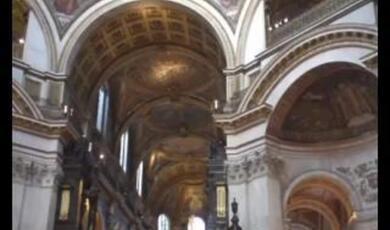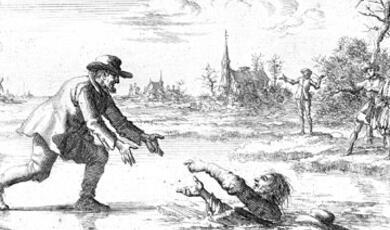A Haberdashery Shop on London Bridge: Journal of a Georgian Gentleman
Share
- Details
- Text
- Audio
- Downloads
- Extra Reading
The fascinating story of eighteenth century haberdasher who recorded what he ate, what he purchased, how he slept and what the weather was like in obsessive detail. He also kept newspaper cuttings and admission tickets, he copied sermons, and collected coins, shells, fossils and books.
Download Text
12 February 2013
A Haberdashery Shop on London Bridge:
Journal of a Georgian Gentleman
Mike Rendell
Thank you for coming to hear my talk on “A haberdashery shop at One London Bridge: the Journal of a Georgian Gentleman”. The gentleman in question is my great great great great grandfather, by the name of Richard Hall, and he was born in London in 1729. The illustration is of a silhouette of Richard made by his daughter when he was in middle age. But first I would like to start with a confession, because it may help put things in perspective. The confession is that I come from a family of inveterate hoarders. We don’t throw anything away, and nor have we done so for three hundred years.
I still have diaries from the 1600s, along with newspapers announcing the death of Oliver Cromwell and the outbreak of the Great Fire in 1666. I have shopping lists going back to 1780 along with ticket stubs, prescriptions, school books, recipes, journals and accounts. And it’s not just his papers – I still have his books, his shell and fossil collections, his chairs, his silver – even his brass bed warming pan!
This then is the background to why, when I got married 25 years ago, one of the first things I carried up the stairs to my wife’s top floor flat was this old trunk. I say old: it was new in 1782, and it cost 10s6d. I know, because I still have the receipt for it. My wife asked what was in it. “Family papers” I replied and with some reluctance she agreed it could be kept behind the door in the hall where it wouldn’t be seen. It was when I started to carry up the first of six tea chests, also loaded with “family papers”, that I discovered that it was not going to be a case of “Love me, love my tea chests”. Discretion being the better part of valour I retreated with my tea chests and put them back into store.
I bided my time and when the flat immediately below came available, I bought it and was then able to unload the remaining papers and items of family furniture.
Over the following twenty odd years I was able to sift through the documents. Most of which were in the hand of Richard Hall. I was helped by the fact that I knew the family tree – for instance that he had a daughter called Martha. It made it all the more puzzling that the diaries referred to “Polly came to stay… “Polly had a birthday” and “Polly unwell”. Similarly there were references to Patty having a birthday, Patty was unwell or went away. It was a while before I realized that Patty is a diminutive form of the name Martha, and that Polly, well, Polly was the parrot.
Making sense of the family story was helped when I came across a manuscript written by Richard Hall in 1800, the year before he died. It is headed “Family and Personal Recollections” and starts with “I have frequently thought of writing a little history of my life interspersed with as much information as I could collect from letters and memorandum in my possession of my family connexion”
He then went on to explain that the family had originally been wealthy landowners in Wiltshire. They had their own coat of arms, and in 1695.
Francis Hall, an only child, was born. He presumably grew up never expecting to have to do a day’s work in his life, but all that was to change in 1720 with the country’s first major stock market crash – the bursting of the South Sea Bubble. The family had pledged most of their land as security for the stock purchases, which had doubled and re-doubled in value over the years. Then one day the crash came and the shares were valueless. The Hall family were not of course alone. Sir Isaac Newton, who amongst other things was Master of the Royal Mint and might be assumed to know a bit about financial matters, lost 30,000 pounds. On the other hand Sir Thomas Guy got out just at the right time and made a profit of 50,000 pounds, enough to endow the hospital which still bears his name today. But for Francis Hall, then aged 25, it meant one thing for certain: he would have to leave home and get himself a job.
This was not an easy task, because he had no trade or qualification. He came to London seeking training and found that the Livery Companies had a stranglehold on apprenticeships – and they had strict rules on age at admission. Francis had already passed his 21st birthday and was ineligible. He therefore had no alternative but to head south of the Thames, to the somewhat rough area of Southwark, because here the long arm of the Livery Company could not reach.
Southwark was a haunt of hookers, pimps and pick-pockets. There were dozens of public houses and doss houses within a stone’s throw of his home in Red Lion Street, just on the edge of the area known as Bridgefoot.
Francis obtained an apprentice-ship as a hosier, making silk stockings. The money was to be made in the embroidery – a hosier could charge three times the amount for a well embroidered stocking than for a plain one. Francis served a 7 year apprenticeship before qualifying in late 1727. He married the following year and in 1729 their only child Richard Hall was born.
At the age of three and a half Richard was “breeched” that is to say he was put into breeches, and he probably then looked like this youngster, shown in a print by Hogarth, wearing his tricorn hat, frock coat, buckled shoes and sword stick.
What is crystal clear is that Francis was determined that his son would be brought up on the straight and narrow – he was the one who could restore the family fortunes. You get the impression that Francis was desperate to “become respectable” – and that would only happen if the Hall family were able to move north of the River Thames into the City of London. Remember, this was the time of the Gin craze and Francis was determined that Richard would follow three principles: good education, hard work, and Christian beliefs (particularly Baptist beliefs). Looking at each in turn:
Richard appears to have had a very thorough education. He had a “good hand” and could write beautifully as in this manuscript which he made and decorated, entitled “Pocket Companion containing selected sentences and some poetry”
I still have many of his school books, including this one of Natural History, from which he could learn that if you crossed a long-necked animal like a camel with a spotted creature such as a leopard, the resulting offspring would be a …giraffe, or camelopardal as it was then called. Remember, this was pre-Darwin.
From the same book Richard would have learned what a rhinoceros looked like, as well as “an unicorn”. I think they are rather lovely.
I still have Richard’s maths books, and these all seem to be trade-specific (i.e. to the business of being a haberdasher) suggesting that at the very least he had private tuition. All the examples are about the cost of lace, silk and so on (“If lace costs 18 shillings and ninepence ha’penny a yard, how much would nine yards cost?”)
I also have pages and pages of his French translations, beautifully written out without correction, English on one side of the page, French on the other. Certainly he was way above my ‘O’ Level French
Hard work –in one of his diary entries Richard writes out his rules for getting up a quarter of an hour earlier every morning from the beginning of April – meaning that he would be rising at 4.30 by the end of August. It really is a reminder of how their lives were dominated by sunlight – and in the winter they almost hibernated!
Francis was a Baptist and the Hall home was close to Carter Lane in Southwark, where Dr Gill held his services. Gill was a man of towering intellect and learning, and Richard looked to him as his mentor – his spiritual guide.
I still have the old family bible – not the King James version, but the earlier Geneva Bible, this one printed in 1562.
As far as I can see Richard left school at fifteen, because that is when he was apprenticed to his father i.e. as a hosier making silk stockings.
By the time he was seventeen Richard started to jot down events in the world around him – in this case the fact that on 16th April 1746 the Duke of Cumberland defeated the rebels at the battle of Culloden. I’ve illustrated it with one of Richard Hall’s own paper cut-outs, showing cavalry on the charge.
He started a separate booklet entitled “Observables” and jotted down as a first entry the fact that two earthquakes had been felt in London exactly one month apart – on 8th February and 8th March 1750. It didn’t take long for the bishop of London to identify the cause of these quakes – it was pornography! Fanny Hill had just been published and the bishop saw the earthquakes as a sign of Divine displeasure. It wasn’t long before people were convinced that the earlier quakes were warm-ups for the Big One, and that a terrible earthquake would occur on 8th April. On that day everyone tried to leave the City, their possessions in carts, wheel barrows – anything they could lay their hands on. The result was chaos – perhaps the worst total gridlock the capital had seen.
When Richard was 25 he added a fourth principle to the ways to succeed in life – marry well! He chose as his bride the 21 year old Eleanor Seward. Her father had made a packet in the aftermath of the Great Fire of London, buying up tracts of farmland North of the City and then selling it on for development. He made enough money to retire in his late thirties to a rambling stately pile at Bengeworth in the Cotswolds. It is now known as the Evesham Hotel. But when old man Seward left for London after the wedding, leaving Richard and his bride to honeymoon at the house, he fell ill on the journey and died very shortly afterwards. His widow stayed up in Town but she too caught a disease and died within a matter of months. So Eleanor, or more accurately Richard, since all of his wife’s property passed to him on marriage, was suddenly extremely wealthy. We therefore have the extraordinary scene where Richard was still a humble sock maker in Southwark, taking time off twice a year to travel down to Evesham to collect his rents and check out his country estates.
Here we have Richard’s cut out of his coach and four, travelling down to the Cotswolds to his deer park and so on. Note the bumpy road with the front wheel of the coach about to crash down heavily over a large rock. This is a reminder of the appalling state of the roads at the time of the 1745 Rebellion.
The various Turnpike Trusts formed in response to the problems of moving the militia around the country led to a rapid improvement in the roads of England and soon we see Richard’s coach enjoying a smoother more comfortable ride.
There was of course still the risk of being stopped by a highway robber brandishing a blunderbuss and calling “ Stand and Deliver”.
But justice was swift and highway robbery was a capital offence. I rather like the nonchalant behaviour of the two riders, chatting away and taking absolutely no notice of the gallows.
Meanwhile things were changing in London at the old bridge. Here is the scene we associate with the bridge the previous century – it was simply no longer fit for purpose. Someone has described it as a wall with gaps in it – and certainly it was hopeless for shipping, which could only go through the arches for a couple of hours either side of high tide, and then only with a great deal of care and good fortune. Equally for pedestrians, crossing the bridge was a nightmare with obstructions from houses, shops gateways etc.
In 1759 work commenced to take out the central pier and to widen the archway to allow ships to pass freely. The carriageway was also widened to 46 feet.
In the following year the Great Stone Gate, for so long a bottleneck, was dismantled and in 1762 the last of the buildings on the bridge was pulled down.
The next year saw the formation of a new pedestrian access onto the bridge direct from St Magnus the Martyr Church.
This left the Corporation of London owning a small piece of land just inside the City boundaries, on the other side of the road to St Magnus, and the decision was made to lease it to Richard in 1766 so that he could build a shop with a four-bedroom house above.
This map by Horwood shows the site of One London Bridge, on the corner of Lower Thames Street, on the other side of the road to the church.
I’ve highlighted the premises in red. Obviously it was in a very prominent position – the very first shop a traveller would come to as he crossed the bridge and entered the City. It is estimated that perhaps 100,000 people a day would have crossed in front of the shop, some on foot, some on horseback. But it must have been noisy – the Water wheel shown just alongside the bridge a few yards from Richard’s home would have been thudding away night and day for a couple of hours either side of high tide, pumping water to the wealthier households of the City.
So this would have been the scene from downriver, looking back towards St Pauls. It shows the bridge as a sleek modern bridge, albeit one built on old foundations.
Here’s the view looking towards the City from the Southwark side of the bridge, showing St Magnus the Martyr church and behind it, the towering column of the Monument.
Richard noted down all the construction costs, and building right by the river obviously wasn’t cheap. The Corporation had granted him a 61 year lease at an annual ground-rent of just under £28 a year. He entered into an agreement with Mr Pounder the builder to put up the building for £850 with another £228/7/7d for surveyors fees and sundry extras. In addition he allowed £5/16 shillings for wall papering.
That wasn’t the end of the matter – he then had to pay over a hundred and eleven pounds for fixtures and fittings besides those in the shop, Kitchen Grates, the Copper, Cistern etc.
What did he sell in his shop? Well, general haberdashery. I have these two trade display cards, one for Halls Velvet and the other for Bat, a type of cotton wadding. It looks as those these would have been displayed on top of the piles of materials on display – nothing “in your face.” And whenever a consignment of lace or calico or whatever was delivered to Richard’s shop he would place an advertisement in the local paper, buy a copy to make sure that the advert was inserted correctly, and then place the paper in his bottom drawer where they remain to this day.
But there was a price to pay for becoming respectable – for coming within the City boundaries. He was now caught by the long arm of the Haberdashers Guild and they weren’t about to let him get away with not having paid fees throughout his working life. So they fined him £25/14/6 (equal to perhaps £2,000) in return for allowing him to trade.
As anyone here will know, owning a property brings with it all the responsibilities of keeping the place in good repair. And for Richard that meant one thing: paying for the constant problems with the privy. Don’t forget, the Privy was in the basement and the property was just by the river banks, so every really high tide would see the Privy flood. Not good when you have a business to run. So Richard seems to have been paying out constantly to have repairs and modifications made. He lists some of them here on the right – “Mr Rogers, bricklayer, for the Jobb at the Privy, Mr Poynder, grate to the Privy, plumbing to the Privy, carpenter at the Privy, ditto casing in pipe” and so on.
So, almost certainly Richard would have had to avail himself of the services of a useful fellow like Richard Harper. This is his trade card, shown courtesy of the British Museum, and he would arrive at night and carry the effluent out through the hall in barrels, emptying them into his cart which would then trundle off across the Thames so that the load could be spread on the market gardens – of Peckham!
Richard was meticulous in keeping records of his insurances. Here with the Hand in Hand Office (on the right) we have buildings insurance in the sum of £900 with policy number 85657 and on the left the contents cover with the Union Office on household Goods, Books plate and Apparel for £500. In addition the Stock in the shop was covered for an impressive £2,100, later increased to £2,300.
No doubt having his insurances helped when the premises next door – a hop warehouse – caught fire. Number One was unscathed but the warehouses at Numbers 2 and 3 London Bridge were totally destroyed, along with the water wheel I mentioned earlier.
That night Richard and his family took refuge in St Magnus the Martyr Church. And this is a drawing of the old water wheel which was destroyed that night. No doubt Richard was glad of the silence, because it was some years before the pumping mechanism was replaced.
This painting done at the time (now in the Guildhall Art Gallery) shows the flames illuminating both the church tower and Richard’s premises immediately to the left.
As a trader one of the great problems faced by Richard was the state of the currency. The Royal Mint hardly minted any silver coins in the second half of the century – because the silver ingots became too expensive. Traditional mines in the West Country dried up, and wars with France interrupted imports from continental mines. So what silver that there was in circulation got more and more worn, making it easy for counterfeiters to pass off shiny blanks and inferior copies as the real thing. And gold wasn’t without its risks. Here is a very fine (and genuine) spade guinea from the reign of George III.
And here is a totally valueless gaming token made from brass and which could easily be mistaken for the real thing in the flickering candlelight at the back of the counting house on a dark afternoon.
Richard loved noting down details about the weather – both on a daily basis and as a review. So, here we have the comment that in January 1776 it was “a remarkable time for Snow, in some cases ten or twelve feet high. Many persons delayed on the roads…. Some persons walked across the Thames from Irongate”.
But this is my favourite comment about the weather, In which Richard writes “Exceeding sharp, Snow, froze very hard. Froze the water in the Chamber-pot”.
Richard always noted in his diary when he did his laundry – as in “Washed a great wash” Here his records suggest that laundry was done every three months.
And a bath? Well, he had one of those once every two months whether he needed one or not! If for any reason the interval was less than two months he regarded it as a single operation describing it as having “resumed my bath” In this case he says he was through Mercy carried very well through it. Very fine day and very warm, grown dull in the evening.”
Richard was a bit of a hypochondriac, always describing some ailment or another. Here he “Was much indisposed with a cold that came on yesterday – head poorly, bowels indifferent and great chilliness, but the Lords hand might have been much heavier. A very fine day, very Cold”
So he would make little books listing remedies for different illnesses, in this case for a stomach upset. “Take two ounces of mutton suet near the kidney, cut it very small and let it simmer in a pint of milk …”
When he got the chance he liked to take visitor to see the sights of London – in this case to the Tower to see the Royal Mint in action. He would also have been able to see the Royal Menagerie, the Royal Regalia and the weapons on display. Here I’ve shown one of the rapiers made by Richard out of paper – the blade about five inches long.
He always liked taking the opportunity to go to a show at Sadlers Wells or Drury Lane, or to attend the circus – in this case Astleys. Astley was the first person to combine music, acrobats, animals and clowns at his riding school.
“Went with Mr Crouch to see the British Musǽum”. One dozen visitorswere allowed in at a time (all escorted). Richard loved going to museums and collections – Cox’s Museum of automata was another favourite. He also went to see the Summer Exhibition at the Royal Academy, once this became an annual feature after 1769.
Richard was not averse to doing the lottery despite his Baptist beliefs. Here he kept his lottery tickets as well as the handbill promoting it. In one year he won a prize of twenty five pounds. Not to be sneezed at!
Richard made his own bindings for his diaries – here are two volumes covering the five years 1780 to 1784. They start with the entry that he took his 25 year old son William into partnership on 1st January and gave him half his trade – in other words they were equal partners.
But disaster struck just ten days later: Richard’s wife Eleanor died of a brain haemorrhage – at midday she complained of a headache, by six that evening she was dead. Richard made this incredibly intricate paper cutting as a memorial to her – it is only just over an inch across and shows Eleanor’s coffin in a temple, and in hand writing he has added her name and age at death (46). Quite possibly the cutting was intended to go between the outer and inner cases of his pocket watch – in other words so that it was kept next to his heart.
Nevertheless he maintained a family tradition by re-marrying before the year was out. To the absolute horror of his children he chose as his bride someone they knew as their aunt – a woman some twenty years younger than Richard. They could see their inheritance disappearing out the window! Here Richard hints at problems to come. “14th December. This day entered into the solemn and very important engagement of a second marriage with Betty Snooke…. Oh that it may prove to be for the mutual comfort of all concerned and never lessen the happiness of my dear children.”
The children boycotted the wedding which took place in Bourton on the Water and issued an ultimatum to Richard – you are not coming back to stay at One London Bridge with that woman. She can come on her own, as can you, but not together as a couple. Richard was outraged, called their bluff, and for three days Richard’s two sons and daughter walked out through the back door as he and his bride walked in the front. On the fourth day he got the message, packed his bags and barely spoke another word to any of his children for the rest of his life. He retained a half share in the business but left the day to day running of the shop to his elder son while he paid for all the bills and shared the profits.
The children’s apprehensions were not groundless, within a year Richard’s wife presented him with a daughter, and two years later a son.
Richard spent most of the year living at Bourton on the Water, and as his new family grew up he entertained them with paper cut outs showing scenes from everyday life – so here we have a ploughing scene, rushes growing in the River Windrush, a dovecote, Richard up a ladder pruning his cherry trees – and a fox-hunting scene.
At Christmas he bought the same present for everybody – a barrel of oysters. But for special friends he gave them Pyfleet oysters costing 4/3d a barrel whereas for less important acquaintances (such as the Baptist Minister) he gave oysters from Colchester costing 3/4d a barrel.
It was the time when Britain was having a mini ice age and in some years he recorded snow on the ground throughout November December January and February. Here we have “Snowed much in the past night, a very deep snow now on the ground, and today it snowed a good deal. Wind very high and very cold” And the next day “Snow lay. A hard frost. Fine day, cold.”
Richard had his square piano sent down from London on the waggon and taught himself how to play. He listed the tunes he learned – and also the times when he had to get the piano tuner round (just about every three months).
On the left a journey up to Evesham – perhaps twenty miles – costing over ten shillings to include the driver, the tolls and so on.
On the right we have a journey up to London in 1783. The travel expenses come to just over three pounds sixteen shillings. On top of that there are “expenses” presumably their supper followed by the overnight stay in Oxford giving a total cost of nearly four pounds fifteen shillings. Multiply that by perhaps eighty to allow for inflation and you see that travel was never cheap!
Here Richard gives details of a trip from Bourton to Weymouth and back – a distance of some 264 miles. On the left he shows what items of luggage he took with him – his great trunk, his blue box his wainscoat (ie wood panelled) box, his green bag, his great coat his shoes and his wig box. Oh and as an afterthought, in case he need a brew when he got there, a steam kettle - making eight items in all.
As he got older he decided to have his own sedan chair made, to carry him about the village. This was in 1795 by which time he was 66. I suspect that either he or his wife may have been a heavyweight by then, and within a short time the chair needed repairs, costing half a crown.
Quite apart from bringing down the odd pipe of port from London by carrier Richard also liked to make his own wine. Here we have his bottling records:
July 27th 1790 Bottled off currant wine from 1789 – run twenty bottles and part of a bottle.
November 15th 1790 tapped a Barrel of Porter – my Wife’s birthday
December 20th 1790 began upon the last Port wine
What I don’t know is whether the consumption of all that alcohol had anything to do with the number of times Richard’s wife suffered a fall. He lists some twenty occasions, but I don’t know if Anna was stoned out of her mind, or suffering from epilepsy, or what. So we have:
1791 March 21st Wife’s bad fall at Parlour Door, fell down stairs, fell coming from the Meeting near our house, fall at Mrs Snooke’s house, fall in Little Cheap Street, and so on.
As he got older Richard started to keep more and more lists – even lists of lists. Household expenses were recorded as they arose, then carried across into separate categories – the butcher, the baker and so on, and then annual totals were compared. I would just draw your attention to the entry two lines up from the bottom – wine, eight pounds three shillings and five pence. Above it we have Taxes of two pounds eight shillings and three-pence. So he was spending three times more on wine than he was paying in taxes. What a man! I have tried, oh how I have tried, to emulate my ancestor but without success!
But all that was to change when war with France had to be paid and the dreaded Income Tax, levied at a straight ten per cent, was introduced. Richard had to pay instalments of five guineas every other month, so suddenly his tax bill went up from under three pounds to something nearer thirty five pounds. He ranted and railed against the tax, seeing it as doubly unfair because customers at the shop had ten per cent less to disposable income to spend on his wares and yet he also had to pay tax on that diminishing income.
I still have Richard’s chamois leather purse containing a few coins – a “cartwheel” penny and two-pence, and as a comparison to show the size of the silver equivalent, a silver two-penny piece.
Every year Richard would jot down what he owned (“Of what I am possessed”) and here we have his account from 1801, the year in which he died. He lists his freehold estate at Bengeworth, which passed under his will to the children of his first marriage, his freehold estate at Clapton (a hamlet near Bourton), a copyhold estate at Sedgeberrow, the leasehold house at London Bridge, and various personal assets including sixteen hundred pounds in South Sea Stock, Eleven hundred pounds lent to Lady Skipworth on mortgage, money owing on promissory notes of 300 pounds and a cash float of 115 pounds. He also recorded a loan to his son in law of 400 pounds.
In 1794 Richard’s eldest son William had decided that he had had enough of the partnership and had resigned from the business, handing over his share to his younger brother Francis. This meant an inventory and valuation had to be prepared for One London Bridge, so that William could be properly recompensed for his share of the furniture and effects. This is the inventory, showing room-by-room where every item was kept, right down to the pictures on the walls, the number of beds and so on. And how many beds do you think there were in a four bedroom house? Sixteen according to the inventory – a reminder that personal space just didn’t exist in 18th Century London.
When William left the business he went off to become a silk-man. In 1820 he was made Master of the Worshipful Company of Haberdashers.
Richard died in 1801 and in his will he left his half share in the business to Francis, who thereby became the sole proprietor of the business. He soldiered on for another quarter of a century.
The shop lease expired on Christmas Day 1826 and Francis expired on the Boxing Day. Whether he died from a broken heart or because he had a heart attack from moving heavy furniture I don’t know, but the end of One London Bridge followed swiftly.
The old bridge was nearing the end of its days. Parliament had approved plans to demolish the bridge and to erect a new one a few yards upstream. Number One was directly in line with the new access roads and was pulled down in 1828.
Here we have Greenwoods map from that year showing the two bridges side by side. One London Bridge stands on an island on its own, soon to be pulled down. Ironically the same road improvements south of the river led to the demolition of Red Lion Street, where Richard was born, so within a matter of months every trace of the Hall empire had disappeared from the face of the earth. In its place the new Rennie bridge, which lasted for another one hundred and fifty years until it was dismantled and carted off to the middle of the desert in Arizona.
And that really concludes the story. I decided to write up my researches as The Journal of a Georgian Gentleman and the book was published a couple of years ago. Now I give talks about Richard’s life, and blog most days* about life in the Eighteenth Century. Thank you all very much for listening!
*http://blog.mikerendell.com
© Mike Rendell 2013
This event was on Tue, 12 Feb 2013
Support Gresham
Gresham College has offered an outstanding education to the public free of charge for over 400 years. Today, Gresham College plays an important role in fostering a love of learning and a greater understanding of ourselves and the world around us. Your donation will help to widen our reach and to broaden our audience, allowing more people to benefit from a high-quality education from some of the brightest minds.


 Login
Login







